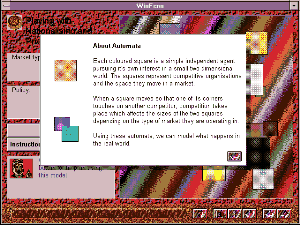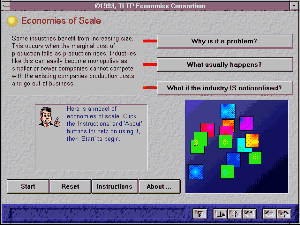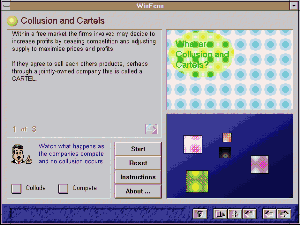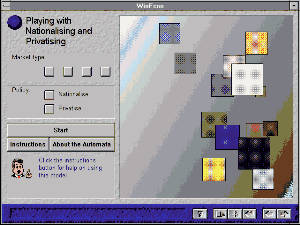Volume 8, Issue 3, 1994
Teaching and Learning Economics using Cellular Automata in Asymmetrix Toolbook.
- Kevin Macken and Ken Randall
- Staffordshire University
Foreword
Having been given one of the least visually tractable topics in the first year Economics curriculum, Privatisation and Nationalisation, to turn into interactive Computer Aided Learning material, our first draft of the module was on the dull side. This module is one of over twenty comprising the TLTP Economics Consortium's main product, WinEcon and looked likely to be the dullest. It would have stayed that way but for a chance remark from a friend on the interest he has in Genetic Algorithms. This led to an idea for simulating a marketplace in Toolbook where competition could take place. After an evening spent with ten empty fields on an otherwise blank Toolbook screen and a short, messy script (i.e. program) the idea seemed workable. The outcome is described below, along with ways the idea could be developed further.
The Simulation
To see it, the simulation consists of differently coloured squares contained within a large rectangular area. These represent competing entities (typically firms) in a market where the size of the square corresponds to the size of the firm. They are called 'Cellular Automata' because each operates independently of the others in a robot-like way, whilst all obey similar or identical rules of behaviour. In action, the squares move and frequently collide with consequences for both parties to the collision. This process continues in real time. Figure 1 shows how this is introduced to the user.To model the different types of market, (oligopoly, perfect competition, monopolistic competition and monopoly) it was only necessary to specify different outcomes to collisions. For instance, if competing in a monopolistic market, larger firms tend to grow in size whilst smaller firms are forced or kept out of the market, culminating in one dominating firm. Therefore in the simulation, the instructions programmed for a monopolistic market were.
- after a collision, make the smaller square smaller
- after a collision, make the bigger square bigger
- create no new squares
- after a collision, make the smaller square bigger
- after a collision, make the bigger square smaller
- create new squares at intervals to restore original complement
Figure 1: Click to see the full-size image
In the four types of market, different sets of rules were programmed to ensure the simulation simulated in a valid manner. (One very keen drawback of this was that it involved staring at moving coloured squares for hours on end - there was no way of speeding the process up except running it on a faster PC - so if the reader is tempted to develop independently minded little beasties like these, bear this in mind!)
The Uses of the Simulation in the WinEcon Module: Privatisation and Nationalisation
To justify the work involved in getting the simulation working, it now needed to enhance the module and be made as interactive as possible. It was therefore decided to use it repeatedly to illustrate points, but in a way which avoided repetition, and to develop a highly interactive screen around it. The fact that it really belongs to another WinEcon module on competition meant it had to be focused on teaching privatisation and nationalisation.In figure 2 the simulation is used to enliven a point - that industries can be nationalised using the argument of economies of scale. To de-emphasize the simulation (because it was being used to illustrate a rather obvious point) it was made smaller. This being the first time it is used in the module it's presence and simplicity served to introduce the user to it. Figure 3 In figure 3 the simulation is again de-emphasized, as it is being used to support a point developed more fully in another module. However, it does something more interesting now by having two modes corresponding to a cartel being in effect or not. This shows the user in a dynamic way the point made in the text and therefore reinforces the learning taking place. Much further development of the model could occur here. (See below.)
Figure 2 Click to see the full-size image
Figure 3 Click to see the full-size image
Figure4 Click to see the full-size image
Figure 4 shows the last time the simulation is used and it forms the basis of the entire screen; hence it fills the screen. The user is invited to set different conditions either by resetting the model or interrupting it. These conditions are to specify one of the four types of market, and/or specify whether a privatisation or nationalisation policy has been enacted. The learning takes place by showing dynamically situations which the user already has read about elsewhere or wishes to investigate. e.g.
- What happens if the firms in a market in perfect competition are nationalised?
- What happens if the firms in an oligopoly are privatised and broken up?
In all of this the user is a long way from a text book on a screen which the module would otherwise have tended to. And, a single simulation has been reused in several parts of the same courseware without diminishing it's effect.
Further Development
As the reader may already have appreciated, this simulation could be used to teach and learn about competition itself, regulation etc. It could be developed much further. The theory behind oligopoly includes Game Theory where separate entities have several strategies to pursue in a similar way. The simulation above could be developed by making the Cellular Automata of different kinds, so that for instance, cartels could be simulated with cheating and colluding squares/automata - where the parameters governing their choice of strategy can be varied by the user. This would lead to a truer simulation of cartels where the cartel-breaker initially benefits greatly but conditions soon favour the rebuilding of the cartel. All this would proceed in real time. Similarly, the squares could be made more purposeful, searching for some kinds of squares and the colliding with them - the reader may know of an application for this idea in economic theory.As Game theory is one of the main tools of analysis in mathematical economics, enhanced versions of this simulation should have many uses in teaching and learning economics.
Conclusion
Module 21 has benefited greatly from the above simulation. The module now has a third way that a user can approach it; the first is from the module menu, analogous to a table of contents; the second is via questions posed in various screens, corresponding to a problem-solving approach; the third is via the highly interactive simulation described above. All three ways point the user to the raw materials that form topics within the module.This increase in the ways of approaching the material boosts the teaching and learning efficacy of the software by catering for different types of user and user need.
Kevin Macken and Ken Randall Computers in Economics Unit The Business School Staffordshire University
References
(1) von Neumann, J., Morgenstern, O. (1944), Theory of Games and Economic Behaviour(2) Parkin, M., King, D. (1992), Economics. Addison-Wesley Publishers Ltd.





